Training Focus Area - Defend Unit
-
TC 3-20.40: TRAINING AND QUALIFICATION - INDIVIDUAL WEAPONS: Provides the outline for all individual weapon's training strategies, resources, prerequisites, and requirements for planning and executing training. It provides a single reference for commanders, staff, planners. This manual defines the Army-standard requirements for individual weapons qualification and establishes those qualifications as prerequisites for continued training for either specific capability certification or collective live-fire training.
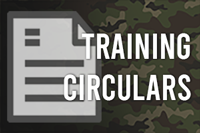
-
Convoy Protection Resources - Includes links to Training Circulars providing convoy protection guidance and requirements, as well as the Sustainment Senior Gunners Toolbox that provides gunners resources such as: Vehicle Crew Evaluators; CPP DIDEA; CPP Gunnery Practical Exercises; MEDEVAC - CASEVAC; CAS UAS; Call for Fire; CBRN 1 Report.
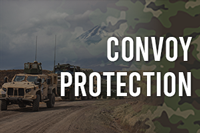
-
TC 4-15.52: SEA-BASED GUNNERY TRAINING: Provides a systematic method to train weapon system proficiency for crews on Army watercraft within sustainment formations. It includes an evaluation of marksmanship and weapon system skills during the collective crew’s training tables and the application of those skills. It defines the required performance measures prior to progressing to the next gate within the Watercraft Gunnery Tables. TC 4-15.52 provides the planning, preparation, and requirements for all crew training, and culminates in weapon system qualification and subsequent live-fire exercise (LFX).

-
Expert Soldier Badge The Expert Soldier Badge, or ESB, is a special skills badge of the United States Army. Similar in appearance to the Combat Action Badge, the ESB is awarded to Soldiers who are neither infantry, special forces, nor combat medics who demonstrate their competence in various warrior tasks, brigade commander selected tasks, land navigation, and physical fitness. The badge was approved in 2019, as a way for Soldiers in other military occupational specialties to certify their competence within their occupation, as well as general combat skills. Through this link, units can coordinate with the ESB Test Team at Fort Jackson to host an ESB event in the future.
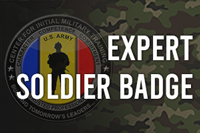
-
TRADOC Pamphlet 672-9, Expert Soldier Badge Tasks This pamphlet provides the performance measures for the Expert Soldier Badge (ESB) tasks. This pamphlet applies to all Soldiers and commissioned officers in the Regular Army, Army National Guard, and U.S. Army Reserve, except those in enlisted career management fields 11, 18, 68 and officer areas of concentration Infantry, Special Forces, or Medical because they compete for the Expert Infantryman Badge or Expert Field Medical Badge. These same career management fields are not authorized to compete for the Expert Soldier Badge.
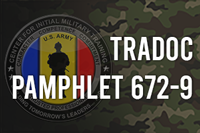
-
07-19: Base Defense Handbook - This handbook provides an overview of Patrol Base (PB) and Forward Operating Base (FOB) operations and presents evolving tactics, techniques, and procedures and useful observations, insights, and lessons from Operation Iraqi Freedom and Operation Enduring Freedom. The fundamentals of security, force protection, threat assessment, and command and control addressed in this handbook are applicable to both PBs and FOBs. Note: Access requires CAC credentials.
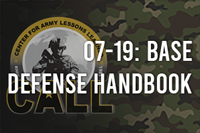 For more lessons learned and the most up-to-date content, visit the CALL SharePoint site. Note: Access requires CAC credentials and site registration by CALL team.
For more lessons learned and the most up-to-date content, visit the CALL SharePoint site. Note: Access requires CAC credentials and site registration by CALL team. -
ATP 3-01.81: Counter-Unnamed Aircraft System (C-UAS), Training - This manual provides brigades and below actions and considerations for conducting local security and counter reconnaissance to deny enemy unmanned aircraft systems from accomplishing their mission. This includes a description of threat unmanned aircraft systems, how to plan for them at brigade and below, defensive and offensive actions for Soldiers and units to take, resources for additional training, and example counter-unmanned aircraft system equipment a unit may be issued or can request.
Appendix A, C-UAS Training: - This appendix includes resources and some considerations when conducting C-UAS training. Units should focus on UAS threat capabilities, the dangers that threat UASs may impose on the unit, and associated battle drills once the UAS is detected. Examples of key tasks to integrate into unit training are -- - Train visual observers how to look for and track UAS.
- - Perform visual air threat recognition training.
- - Practice various passive measures.
- - Establish and use an early warning notification network.
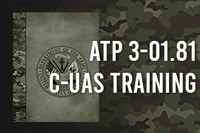
-
24-901: Surviving the Swarm (C-UAS) Handbook - This handbook provides recommended C-UAS Tactics, Techniques, and Procedures at the Brigade and Below Note: Access requires CAC credentials.
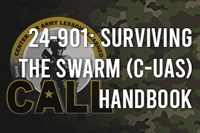 For more lessons learned and the most up-to-date content, visit the CALL SharePoint site. Note: Access requires CAC credentials and site registration by CALL team.
For more lessons learned and the most up-to-date content, visit the CALL SharePoint site. Note: Access requires CAC credentials and site registration by CALL team. -
Counter-small Unmanned Aircraft Systems (C-sUAS) Home Station Training Support Package & Administrative Guide: - The Fires CoE's current version includes observations of best practices for C-sUAS operations in theater, lessons learned at the JCU enhancing HST, and an enterprise effort identifying critical individual and collective tasks. It includes -
- - Individual training & self-development opportunities.
- - How to gain the authorities and requisite skills to train at home station.
- - Offers “a way” to organize for C-sUAS engagement operations, tasks to train, and concepts to understand to plan C-sUAS operations.
- - Training scenarios for the FAAD C2 embedded trainer (CDS3) to enable sets and reps early and often.
- - Planning considerations and timelines after listening to Commanders and understanding the complexity of flying sUAS and conducting C-sUAS engagements at home station.
Note: Access requires CAC credentials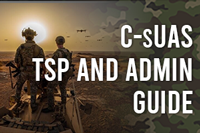 For additional home station training materials from the Fires Center of Excellence, Directorate of Training and Doctrine, visit the FCoE C-UAS Training Support MS Teams site. Note: Access requires CAC credentials
For additional home station training materials from the Fires Center of Excellence, Directorate of Training and Doctrine, visit the FCoE C-UAS Training Support MS Teams site. Note: Access requires CAC credentials -
ATP 3-21.20: Infantry Battalion - This manual provides an in depth doctrinal basis for the occupation of an assembly area. It describes the fundamentals of quartering party operations, and provides an illustration of an assembly area to deepen understanding and comprehension.
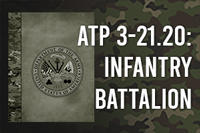
-
ATP 3-21.8: Infantry Rifle Platoon and Squad - This manual provides in depth doctrinal basis on defense, such as Engagement Area and Fighting Position Construction. Addition tactical enabling operations & activities, such as Tactical Deception, Security, Security Operations, and Troop Movement. Along with critical battles to react and survive in common combat situations.
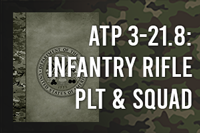
-
GTA 07-06-001: Fighting Positions Construction - This graphic training aid (GTA) provides guidance on the construction of dismounted fighting positions. The GTA describes both combat tested tactics and procedures, and the basic techniques associated with the conduct of constructing a fighting position. The standards described in this GTA are IAW TC 3-21.75 The Warrior Ethos and Soldier Combat Skills. Note: Access requires CAC credentials.
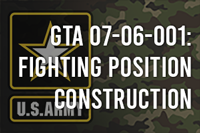
24-05: Command Post Survivability Handbook
- Future wars will be fought in a battlefield where increasingly transparent conditions will
create adversarial sensing and strike options that require an increased survivability focus.
This handbook emphasizes that focus specifically on command post (CP) survivability.
Note: Access requires CAC credentials.
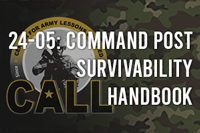
For more lessons learned and the most
up-to-date content, visit the CALL SharePoint site. Note: Access requires CAC credentials
and site registration by CALL team.

